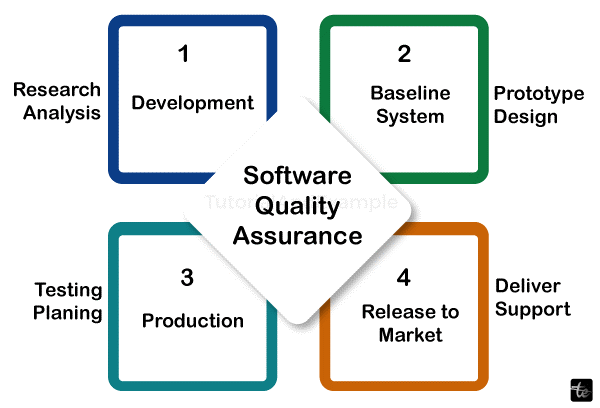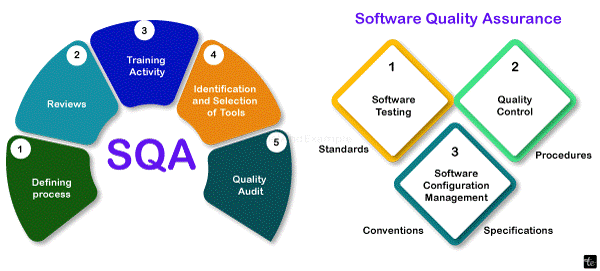SQA Plan in Software Engineering
Introduction
SQA is an acronym that stands for Software Quality Assurance. It is used for guaranteeing software quality. The group of actions guarantee standards, methods, and procedures are appropriate for the project and carried out correctly.

Software quality assurance is a procedure that runs concurrently with software development. It focuses on streamlining the software development process to stop issues before they become serious ones. Software quality assurance is one type of umbrella activity used throughout the software process.
Objectives and Goals of Quality Assurance Plan
Developing an excellent quality assurance plan is a fascinating project. Let's clarify our goals and objectives before we get going to ensure we're headed in the correct direction.
Here are a few essential things to remember:
- Customer requirements and expectations: Put yourself in your client's position and find out what they genuinely need from your offerings. This will point you toward surpassing their demands and offering total satisfaction.
- Company Objectives: Every business has unique aspirations and goals. Establish the objectives of your business and adjust your quality assurance strategy accordingly. It is similar to finding the right balance between your dreams and the route to success.
- Industry Standards: Who would like to be forgotten? Keep up with the competition by learning about and applying industry standards. By being aware of the benchmarks, you can ensure that your goods and services meet or exceed the established criteria.
- Specific: Determine the areas you want to focus on or improve. Ideological notions will not do. Let's be more precise and concentrate on the goal.
- Measurable: To monitor your development, set quantifiable goals. It is comparable to using a fitness tracker as part of your plan for quality assurance. Establish benchmarks and measurements that will enable you to track your development and recognize your accomplishments.
- Achievable: While dreams are admirable, let's be realistic, shall we? Make sure your objectives and goals are reachable. It is comparable to trying to climb a challenging but reachable mountain. Keep in mind that little steps result in large ones!
- Relevant: Follow the course that aligns with your primary goal. Your company's needs and the desired quality improvements should be the focus of your objectives and goals. It's similar to picking the appropriate tool for the job—the perfect fit that ensures your efforts are worthwhile and have an influence.
- Time-bound: Let's establish due dates since time doesn't wait on anyone. Make a schedule for accomplishing your goals and aspirations. It inspires and helps you stay on course like a countdown clock.
If you can see these objectives and targets, your quality assurance plan will have a clear direction and a tactical roadmap.
Create a plan for quality assurance
Before being implemented, a SQA needs a Quality Assurance plan, just like a test requires a test plan. Ensuring the end user receives the highest quality is the primary goal of creating a SQA plan.
When creating a SQA plan, the QA team ought to concentrate on the following areas:
Determine the SQA team's position and duties
- The SQA testing team develops potential scenarios, protocols, and scripts and plans the tests.
- The group establishes best practices, protocols, and techniques for software quality assurance testing and preserving product quality.
- Using bug-tracking tools, the team reports any software quality assurance operations flaws.
- The group also finds and examines issues with how the program operates or produces its results.
- It is also in charge of carrying out audits, checks, and follow-up tasks.
- The group also provides process implementers with training.
List of work items that the SQA auditor will examine and check
- The SQA auditor documents the risk management activities.
- SQA auditors also prepare metrics reports and required budget estimates.
- An SQA auditor does the planning and preparation of test documents.
- SQA auditors are in charge of planning human resources, creating training programs, and overseeing the entire organization.
- The responsibility for tracking and managing the gathered metrics falls on the SQA auditor.
- The problem management report is another work output that a SQA auditor will examine and audit.
- The test report documents will also be examined and audited by a SQA auditor.
Make a schedule for completing the SQA tasks
When describing the tasks the SQA auditor must perform in this step, the Test Manager should emphasize SQA activities and the work output for each job. The project development timeline frequently establishes the SQA schedule.

Describe the procedures and standards
The software quality assurance strategy should adhere to the following specific methods:
- Outlining the procedures and guidelines meant to prevent errors from occurring during the management process.
- Record and gather the protocols and rules.
- Teach and prepare employees to follow the rules and regulations.
Examine the procedure
To ensure that the rules and policy processes are followed correctly, the complete set of SQA approaches should be examined regularly.
There are five essential reviews to note:
- Examining the project schedule
- Examining the software requirement analysis that was completed
- Examining the test design and plan
- Verifying every step of the procedure before the official release
- Examining the project's closure.
Elements of Software Quality Assurance
Ten crucial details of SQA are mentioned below for your reference:
- Software Engineering Standards: To make sure that we follow the guidelines above for software engineering teams, SQA teams are essential.
- Technical Reviews and Audits: At each level of the SDLC, active and passive verification/validation approaches are used.
- Software Testing for Quality Control: This type of testing looks for problems in the program.
- Error Collection and Analysis: This process involves tracking, monitoring, and analyzing defects to pinpoint issue areas and failure patterns.
- Metrics and Measurement: SQA uses a range of tests and measurements to obtain data regarding the efficiency and caliber of the processes and products.
- Change Management: Atavistically promote controlled change and offer robust procedures that prevent unintended negative consequences.
- Vendor Management: Assist tool vendors and contractors to guarantee the group's success as a whole.
- Safety and Security Management: One of SQA's primary responsibilities is to find vulnerabilities and alert people to them in advance.
- Risk Management: To support well-informed decision-making, the SQA teams lead the charge in risk identification, analysis, and mitigation.
- Education: Ongoing education must stay updated with industry trends, standards, and tools.
Software Quality Assurance Activities
- SQA Management Plan: Plan out how you will perform the SQA throughout the project. Consider which combination of software engineering tasks is most appropriate for the given project. Verify the SQA team's skill level.
- Set The Check Points: The SQA team ought to establish checkpoints. Analyze the project's performance using the information gathered from various checkpoints.
- Multi testing Strategy: Don't rely just on one kind of testing. Use the various testing approaches at your disposal.
- Measure Change Impact: Occasionally, fixing a mistake results in the introduction of new errors. Maintain track of the change's influence on the project. Reset the further modification to verify that this update is compatible with the entire project.
- Manage Good Relations: Maintaining positive working relationships with other teams involved in the project development is essential in the workplace. Poor communication between the SQA and programming teams will directly and negatively affect the project.
Advantage of SQA
- SQA creates software of the highest caliber.
- Time and money are saved with high-quality applications.
- SQA helps to improve reliability.
- SQA is advantageous if there is no maintenance for an extended period.
- A company's market share increases with high-quality commercial software.
- Enhancing the software development process.
- Enhances the software's quality.
- It lowers upkeep expenses. If the release is executed flawlessly, your business can go on to the next big thing and put it behind it. When a product with persistent problems is released, your company is forced to engage in an expensive, time-consuming, and never-ending cycle of repairs.
Disadvantage of SQA
The use of quality assurance has several drawbacks. Some of them include increasing resources and hiring more staff to maintain quality, among many other things.
Conclusion
To ensure effective and flawless delivery devoid of any flaws, software testers, project managers, and quality assurance specialists employ strategies and procedures for software quality assurance that apply to all sizes of businesses.
A software quality assurance plan is necessary to keep the commitments given to clients and customers. It is important to remember that scheduling is essential to putting the SQA work into practice. Planning will help you manage your time and complete the software development project on time, satisfying customers and keeping your company's reputation intact.